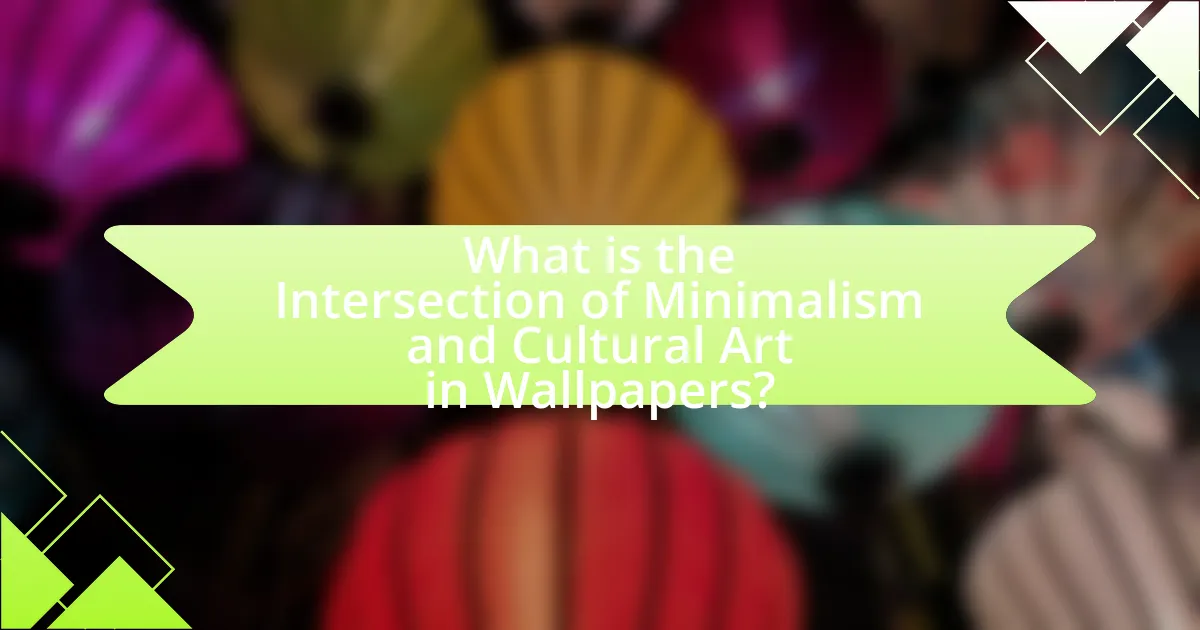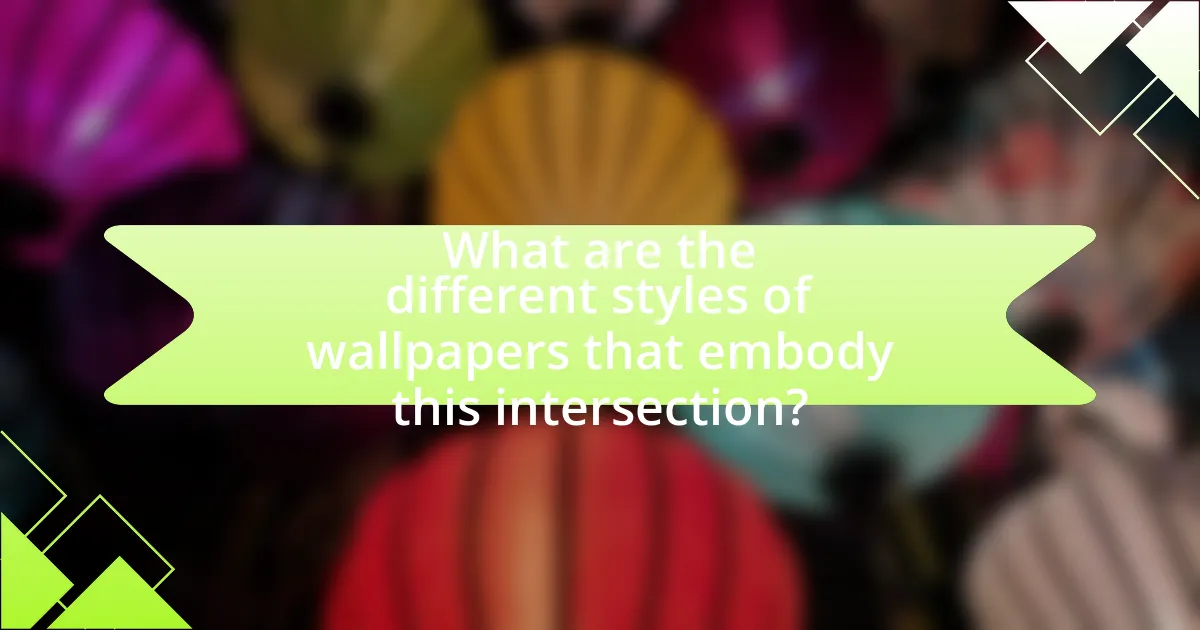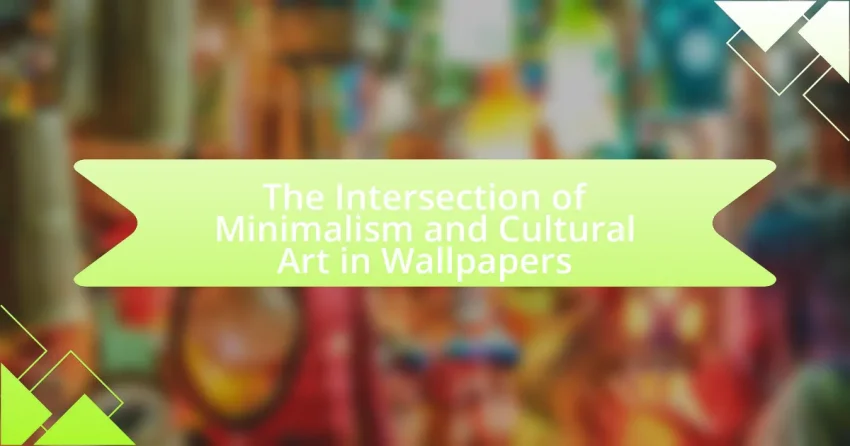The article explores the intersection of minimalism and cultural art in wallpaper design, highlighting how these two styles can coexist to create visually appealing and meaningful spaces. It examines the principles of minimalism, such as simplicity and functionality, alongside the rich patterns and colors of cultural art that reflect diverse traditions. The discussion includes emerging trends, popular motifs, and best practices for incorporating these wallpapers into interior design, while also addressing potential challenges and maintenance tips. This fusion not only enhances aesthetic appeal but also resonates with contemporary societal values, emphasizing cultural identity and sustainability.

What is the Intersection of Minimalism and Cultural Art in Wallpapers?
The intersection of minimalism and cultural art in wallpapers lies in the fusion of simplicity and cultural expression. Minimalism emphasizes clean lines, open spaces, and a reduction of excess, while cultural art incorporates traditional motifs, colors, and symbols that reflect specific cultural identities. This combination results in wallpapers that maintain a minimalist aesthetic while celebrating cultural heritage, allowing for a modern interpretation of traditional designs. For instance, contemporary wallpaper designs may feature subtle patterns inspired by indigenous art forms, blending minimalistic elements with rich cultural narratives, thus creating a visually striking yet understated decor option.
How do minimalism and cultural art influence wallpaper design?
Minimalism and cultural art significantly influence wallpaper design by promoting simplicity and meaningful aesthetics. Minimalism emphasizes clean lines, neutral colors, and uncluttered patterns, which lead to wallpapers that create a serene environment and enhance spatial perception. For example, Scandinavian design principles often incorporate minimalistic elements, resulting in wallpapers that focus on subtle textures and muted tones.
Conversely, cultural art introduces rich patterns, vibrant colors, and historical motifs, reflecting the heritage and identity of different cultures. For instance, traditional Japanese art influences wallpaper through intricate designs like cherry blossoms or waves, adding depth and storytelling to the space. The combination of these two influences results in wallpapers that balance simplicity with cultural significance, appealing to modern sensibilities while honoring artistic traditions.
This interplay is evident in contemporary wallpaper collections that merge minimalistic designs with cultural motifs, showcasing how these two styles can coexist and enhance interior aesthetics.
What are the key principles of minimalism in wallpaper design?
The key principles of minimalism in wallpaper design include simplicity, functionality, and the use of neutral colors. Simplicity emphasizes clean lines and uncluttered patterns, allowing the wallpaper to enhance rather than dominate a space. Functionality focuses on the practical aspects of wallpaper, ensuring it serves its purpose without unnecessary embellishments. The use of neutral colors creates a calming atmosphere and allows for versatility in various interior styles. These principles are rooted in the broader minimalist philosophy, which advocates for “less is more,” promoting a serene and organized environment.
How does cultural art contribute to the aesthetics of wallpapers?
Cultural art enhances the aesthetics of wallpapers by infusing them with unique patterns, colors, and historical significance that reflect diverse traditions. For instance, traditional Japanese art often features intricate designs and natural motifs, which can create a serene and harmonious atmosphere in interior spaces. Additionally, cultural art can evoke emotional responses and tell stories, making wallpapers not just decorative elements but also narrative pieces that connect viewers to specific cultural heritages. The incorporation of these artistic elements can elevate the visual appeal and depth of wallpapers, transforming them into focal points in minimalist designs while maintaining a balance between simplicity and cultural richness.
Why is the intersection of these two styles significant in contemporary design?
The intersection of minimalism and cultural art is significant in contemporary design because it creates a unique aesthetic that balances simplicity with rich cultural narratives. This fusion allows designers to convey complex stories and emotions through minimalistic forms, making art accessible and relatable. For instance, the use of cultural motifs in a minimalist framework can enhance visual appeal while maintaining clarity, as seen in various wallpaper designs that incorporate traditional patterns with a modern twist. This approach not only honors cultural heritage but also resonates with a global audience, reflecting the increasing demand for diversity in design.
What trends are emerging from the fusion of minimalism and cultural art?
Emerging trends from the fusion of minimalism and cultural art include the use of simplified forms and patterns that reflect cultural narratives while maintaining a clean aesthetic. This trend is evident in wallpaper designs that incorporate traditional motifs, such as geometric shapes or symbolic imagery, presented in a restrained color palette. For instance, designers are increasingly utilizing cultural symbols in a way that emphasizes negative space, allowing the art to breathe and resonate with viewers. This approach not only honors cultural heritage but also aligns with contemporary minimalist design principles, creating a harmonious balance between cultural expression and modern simplicity.
How does this intersection reflect societal values and preferences?
The intersection of minimalism and cultural art in wallpapers reflects societal values and preferences by emphasizing simplicity and cultural identity. This combination showcases a preference for clean aesthetics that resonate with contemporary lifestyles while honoring traditional artistic expressions. For instance, the rise of minimalism in design aligns with a societal shift towards sustainability and mindfulness, as seen in the increasing demand for eco-friendly materials and designs that promote tranquility. Additionally, cultural art elements incorporated into minimalist wallpapers serve to celebrate diversity and heritage, reflecting a growing appreciation for multiculturalism in modern society. This trend is supported by market research indicating that consumers increasingly seek products that not only enhance their living spaces but also convey personal and cultural narratives.

What are the different styles of wallpapers that embody this intersection?
Different styles of wallpapers that embody the intersection of minimalism and cultural art include Scandinavian-inspired designs, Japanese Washi patterns, and geometric motifs influenced by traditional African art. Scandinavian-inspired designs often feature simple, clean lines and muted colors, reflecting minimalism while incorporating elements of nature and cultural heritage. Japanese Washi patterns utilize delicate, understated designs that emphasize craftsmanship and cultural significance, aligning with minimalist aesthetics. Geometric motifs from traditional African art showcase bold shapes and colors, yet can be presented in a simplified manner that resonates with minimalism. These styles illustrate how cultural art can be harmoniously integrated into minimalist wallpaper design, creating visually appealing and meaningful spaces.
What types of minimalist wallpapers are available?
Various types of minimalist wallpapers are available, including geometric patterns, solid colors, nature-inspired designs, and abstract art. Geometric patterns often feature simple shapes and lines that create a clean aesthetic, while solid colors provide a uniform and calming backdrop. Nature-inspired designs may include subtle representations of landscapes or botanical elements, emphasizing simplicity and tranquility. Abstract art wallpapers utilize minimalistic forms and colors to evoke emotion without clutter. Each type aligns with minimalist principles, focusing on simplicity and functionality in design.
How do color palettes play a role in minimalist wallpaper designs?
Color palettes are crucial in minimalist wallpaper designs as they establish the overall mood and aesthetic of the space. In minimalist design, a limited color palette often emphasizes simplicity and tranquility, allowing for a clean and uncluttered visual experience. For instance, the use of neutral tones like whites, grays, and beiges can create a serene environment, while subtle variations in these colors can add depth without overwhelming the senses. Research indicates that color psychology plays a significant role in how individuals perceive and interact with their surroundings, supporting the idea that carefully chosen color palettes can enhance the minimalist ethos by promoting calmness and focus.
What patterns are commonly found in minimalist wallpapers?
Common patterns found in minimalist wallpapers include geometric shapes, lines, and organic forms. Geometric patterns often feature simple, repetitive designs such as triangles, circles, and squares, which create a sense of order and balance. Lines can be horizontal, vertical, or diagonal, contributing to a clean and structured aesthetic. Organic forms, inspired by nature, may include subtle representations of leaves or waves, adding a touch of softness to the overall design. These patterns emphasize simplicity and functionality, aligning with minimalist principles that prioritize essential elements over decorative excess.
What cultural art influences can be seen in wallpaper designs?
Cultural art influences in wallpaper designs include motifs and styles derived from various traditions such as Japanese ukiyo-e prints, Indian block printing, and European Art Nouveau. These influences manifest through the use of intricate patterns, natural themes, and vibrant colors that reflect the cultural heritage of their origins. For instance, Japanese designs often feature elements like cherry blossoms and waves, while Indian block prints showcase geometric patterns and floral designs. Historical context supports this, as wallpaper design has evolved by incorporating diverse cultural aesthetics, particularly during the 18th and 19th centuries when global trade expanded artistic exchange.
Which cultural motifs are popular in contemporary wallpaper art?
Contemporary wallpaper art prominently features cultural motifs such as botanical patterns, geometric designs, and ethnic prints. Botanical patterns draw inspiration from nature, reflecting a trend towards biophilic design, which has been shown to enhance well-being and connection to the environment. Geometric designs often incorporate elements from various cultures, such as Moroccan tiles or Scandinavian simplicity, appealing to modern aesthetics while maintaining cultural significance. Ethnic prints, including African tribal patterns and Asian textiles, celebrate diversity and heritage, resonating with a global audience. These motifs not only serve decorative purposes but also convey cultural narratives, making them integral to contemporary wallpaper design.
How do traditional art forms inspire modern wallpaper designs?
Traditional art forms inspire modern wallpaper designs by providing rich visual motifs, color palettes, and cultural narratives that enhance contemporary aesthetics. For instance, patterns derived from traditional textiles, ceramics, and paintings are often reinterpreted in wallpaper, allowing designers to incorporate historical significance and cultural identity into their work. The use of traditional Japanese motifs, such as cherry blossoms and waves, can be seen in modern wallpaper collections, reflecting a blend of heritage and innovation. This integration not only preserves cultural elements but also appeals to consumers seeking authenticity and connection to history in their living spaces.

How can one effectively incorporate these wallpapers into interior design?
To effectively incorporate wallpapers that blend minimalism and cultural art into interior design, one should select designs that complement the existing color palette and furnishings of the space. For instance, a wallpaper featuring subtle cultural motifs can enhance a minimalist room by adding depth without overwhelming the aesthetic. Research indicates that using wallpapers with a limited color scheme can create a cohesive look, as seen in studies on color theory and spatial perception, which suggest that harmonious colors promote a sense of tranquility and balance in interior spaces. Additionally, strategically placing these wallpapers on accent walls or in smaller areas can draw attention to specific features while maintaining an uncluttered overall appearance.
What are the best practices for selecting wallpapers that blend minimalism and cultural art?
To select wallpapers that effectively blend minimalism and cultural art, prioritize designs that feature simple patterns or motifs inspired by cultural elements. This approach ensures that the wallpaper maintains a clean aesthetic while celebrating cultural heritage. For instance, choosing wallpapers with subtle geometric shapes or monochromatic color schemes can highlight cultural symbols without overwhelming the space. Additionally, consider the scale of the design; larger, bolder cultural motifs can serve as focal points in minimalist settings, while smaller patterns can add texture without clutter. Research indicates that integrating cultural art into minimalist designs can enhance the emotional connection to the space, making it more inviting and personal.
How can one balance minimalist and cultural elements in a room?
To balance minimalist and cultural elements in a room, one should select a few key cultural pieces that resonate with the overall aesthetic while maintaining a clean and uncluttered environment. For instance, incorporating a single, striking cultural artwork or artifact can serve as a focal point without overwhelming the space. This approach aligns with minimalist principles, which emphasize simplicity and functionality, while still honoring cultural heritage. Research indicates that well-curated cultural elements can enhance the emotional and aesthetic value of a minimalist space, creating a harmonious blend that reflects personal identity and cultural appreciation.
What tips can enhance the visual impact of these wallpapers in a space?
To enhance the visual impact of wallpapers in a space, consider using a cohesive color palette that complements the wallpaper design. A well-chosen color scheme can create harmony and draw attention to the wallpaper’s cultural art elements. Additionally, strategically placing lighting, such as accent lights or spotlights, can highlight the textures and patterns of the wallpaper, making them more visually striking. Furthermore, incorporating minimalistic furniture and decor can prevent visual clutter, allowing the wallpaper to serve as a focal point in the room. Research indicates that well-lit and thoughtfully arranged spaces can significantly improve aesthetic appeal, reinforcing the importance of these tips in achieving a visually impactful environment.
What common challenges might arise when using these wallpapers?
Common challenges that might arise when using wallpapers that blend minimalism and cultural art include difficulty in achieving a cohesive aesthetic, potential cultural appropriation, and maintenance issues. Achieving a cohesive aesthetic can be challenging because minimalism emphasizes simplicity, while cultural art often features intricate designs and vibrant colors, which may clash. Cultural appropriation can occur if the wallpaper designs are used without understanding or respecting their cultural significance, leading to ethical concerns. Additionally, maintenance can be problematic, as some wallpapers may require special cleaning methods or materials to preserve their appearance, particularly if they feature delicate or detailed artwork.
How can one troubleshoot issues related to color and pattern clashes?
To troubleshoot issues related to color and pattern clashes, one should first analyze the color wheel to identify complementary colors that can harmonize the design. This method is supported by color theory, which states that colors opposite each other on the wheel create visual balance. Next, one should assess the scale of patterns; larger patterns can overwhelm smaller ones, so pairing a bold pattern with a subtle one can create a cohesive look. Additionally, using a neutral base can help mitigate clashes, as it allows colors and patterns to stand out without competing. This approach is validated by design principles that emphasize balance and contrast in visual aesthetics.
What maintenance tips are essential for preserving the integrity of these wallpapers?
To preserve the integrity of wallpapers, regular cleaning and careful handling are essential. Cleaning should involve using a soft, damp cloth to gently wipe the surface, avoiding harsh chemicals that can damage the material. Additionally, maintaining a stable indoor environment with controlled humidity and temperature helps prevent warping and peeling. It is also important to avoid direct sunlight exposure, as UV rays can fade colors and weaken the wallpaper over time. These practices are supported by industry guidelines, which emphasize the importance of gentle maintenance to extend the lifespan of wallpaper materials.
